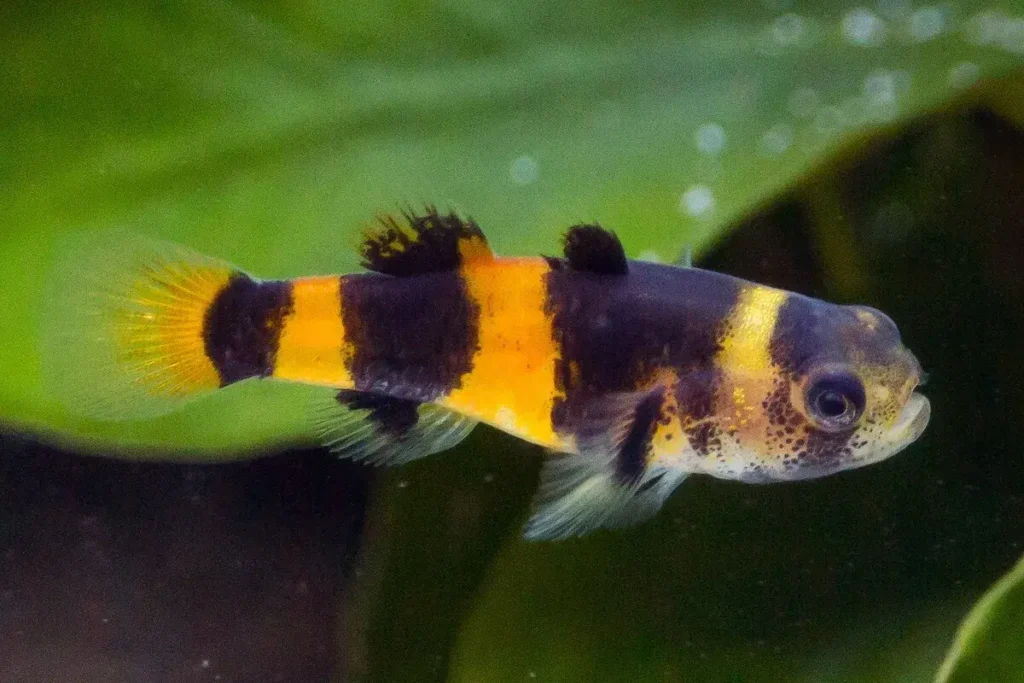
Size
1.7 inches
Physical Characteristics and Behavior
This species lays its eggs in concealed locations, making flower pots, ceramic tubes, shells, and plastic film canisters ideal spawning containers. In general, women of reproductive age, especially pregnant females, tend to have a more voluptuous physique than men. Males in spawning conditions are reddish overall, with the dark bars on their bodies becoming lighter in color. In females, the initial yellow bar becomes more vibrant.
Keeping as Pet

Tank Requirements and Care
- Care
Since this species prefers to spawn in secret places, flower pots, ceramic tubes, shells, and plastic film canisters are perfect spawning vessels. Women of childbearing age typically have a more curvaceous figure than men, especially those who are pregnant. Males in spawning conditions have a reddish overall appearance and lighter-colored black bars on their bodies. The initial yellow band gets brighter in females.
- Water Conditions
The following ecology is the fish’s natural habitat: water Temperature: 73-79°F/23-26°C; Hardness: 2- 15°H; pH: Seems to perform best in mildly acidic to neutral settings between 6.5 and 7.5.
- Diet
Carnivorous bumblebee gobies eat insect larvae, small aquatic invertebrates, and fish larvae in the wild. One of the hardest concerns for any aquarist is feeding their gobies. The best food to give them is live food, which will most closely resemble what they consume in the wild. However, live food is costly and frequently elusive. They will consume only live food that moves sufficiently to set off their feeding reflex. Frozen and dried goods won’t be considered. Home food cultures can be developed to give an almost constant supply of living food, saving the price of having to buy it. They will eat brine shrimp, blood worms, tubifex worms, mosquito larvae, and daphnia magna.
- Tank Companions
Finding tank mates for these fish can be challenging because brackish environments can only support a relatively small range of species, much like platy fish. Other Bumblebee Gobies make the ideal tank companions. To build a flourishing community tank, search for fish that are peaceful and of comparable size. When seeking for other tank mates, size is very crucial. The gobies will spend much of their time hiding because larger fish will stress them out excessively. The fish listed below make good tank companions: Glass fish, Mudskippers, Pufferfish (smaller species), Columbian Shark Catfish, Archerfish, Guppies, Mollies and Endlers.
- Tank Situation
The Bumblebee Goby is a resident of Southeast Asia’s mangrove forests and shallow, brackish river estuaries. They hardly ever swim in open water and are frequently seen swimming on the benthos. In order to have a lot of hiding places, bumblebee gobies like to reside in locations with a lot of plants and various kinds of waste. They frequently can be observed hiding amid the roots of mangrove trees. Typically, fine sediments like fine-grained sand and fine muck make up their native environments.
- Tank Setup
Replicating their natural habitat is your aquarium’s primary objective. They will feel more at ease and their stress levels will decrease as a result. For only one Bumblebee Goby, you will need a tank that is at least 10 gallons large. A school of up to 8 Bumblebee Gobies can fit in a 30 gallon tank. Although they may tolerate some degree of fluctuating water conditions, bumblebee gobies need to be kept at a constant salinity. A salinity grade of between 1.002 and 1.006 is necessary for them. They can be kept in either entirely fresh or slightly brackish water. After you pick them, though, you must maintain them in this water for the rest of their lives because switching them between brackish and freshwater (or vice versa) can cause osmotic stress and even death.
Table





